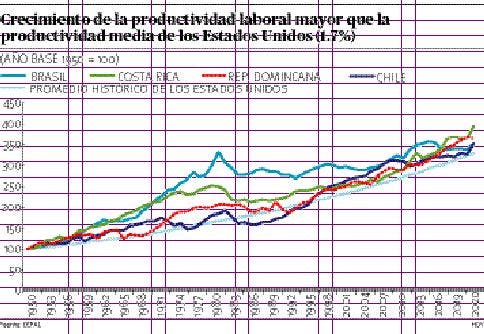The country is among four Latin American and Caribbean nations whose labor productivity has grown more than that of the United States of America.
The Dominican Republic is better off than most Latin American and Caribbean countries in increasing labor productivity.
Although labor productivity in the region has remained stagnant since 1980, that of the Dominican Republic and three other countries has increased more than that of the United States, according to data from ECLAC.
Since 1980, a trend towards stagnation has been observed, since between that year and 2021, labor productivity contracted at an average rate of 0.1% year-on-year, which contrasts with what happened in the period between 1950 and 1979, when labor productivity grew on average by 2.6% annually, higher than the average growth rate recorded in the United States, which was 2.0%.
The increase in labour productivity experienced by the region in the period analysed was mainly due to changes in the allocation of jobs within each productive sector, which contributed 0.83% of the total change of 0.88% experienced by productivity in that period.
Only 0.05 of the 0.88 is associated with the effects of the reallocation of work between the different productive sectors. In the case of the Dominican Republic, 2.47 (the highest among countries) was due to the former and 0.14 to the latter.
“That is to say, after 41 years, the region has not been able to return to the productivity levels it had before the debt crisis. The performance achieved between 2004 and 2013 brought it very close to the 1980 level, but the end of the boom in raw material prices caused a break in this trend and, from then on, a permanent downward trend was recorded,” states a report by ECLAC and the International Labour Organization (ILO) on “Labour productivity dynamics in Latin America”, Labour Situation in Latin America and the Caribbean.
That has not been the case in the Dominican Republic, which is among four countries (the other three being Brazil, Chile, and Costa Rica) that have achieved higher labor productivity growth than the United States. It is worth noting that labor productivity in Bolivia, Colombia, and Peru have been approaching higher labor productivity growth in recent years than in the United States.
The opposite has occurred in most economies in the region, where labour productivity has grown by less than 1.7%, thereby widening the gap that existed in 1950. Furthermore, since the 1990s, labour productivity growth in the region has slowed.
Despite the improved position of the Dominican Republic, it must not let down its guard. It must continue to work to create the conditions for a further increase in labour productivity.
One of the reasons that, according to the ECLAC and ILO report, lead to the discouraging performance of total factor productivity is the low investment rates shown by the economies of the region.
The lack of appropriate infrastructure (ports, roads, electricity, water and communication systems) makes the production of goods and services with the same amount of inputs more difficult for a company in the region than for a company in a country.
Similarly, low levels of investment in research and development and technological innovation could also reduce total factor productivity in the region’s economies.
Low levels of human capital accumulation, particularly in health and education, could lead to a divergence in the region’s total factor productivity from other economies.
The presence of institutional barriers, which increase the cost of operating in the region, could also induce the observed dynamics in said productivity.
Furthermore, the lack of equal access to opportunities, sources of financing and, in general, to the development of economic and educational activities can explain the limitations to the productive potential of the region, especially in light of the high levels of informality that characterize the economies.

















